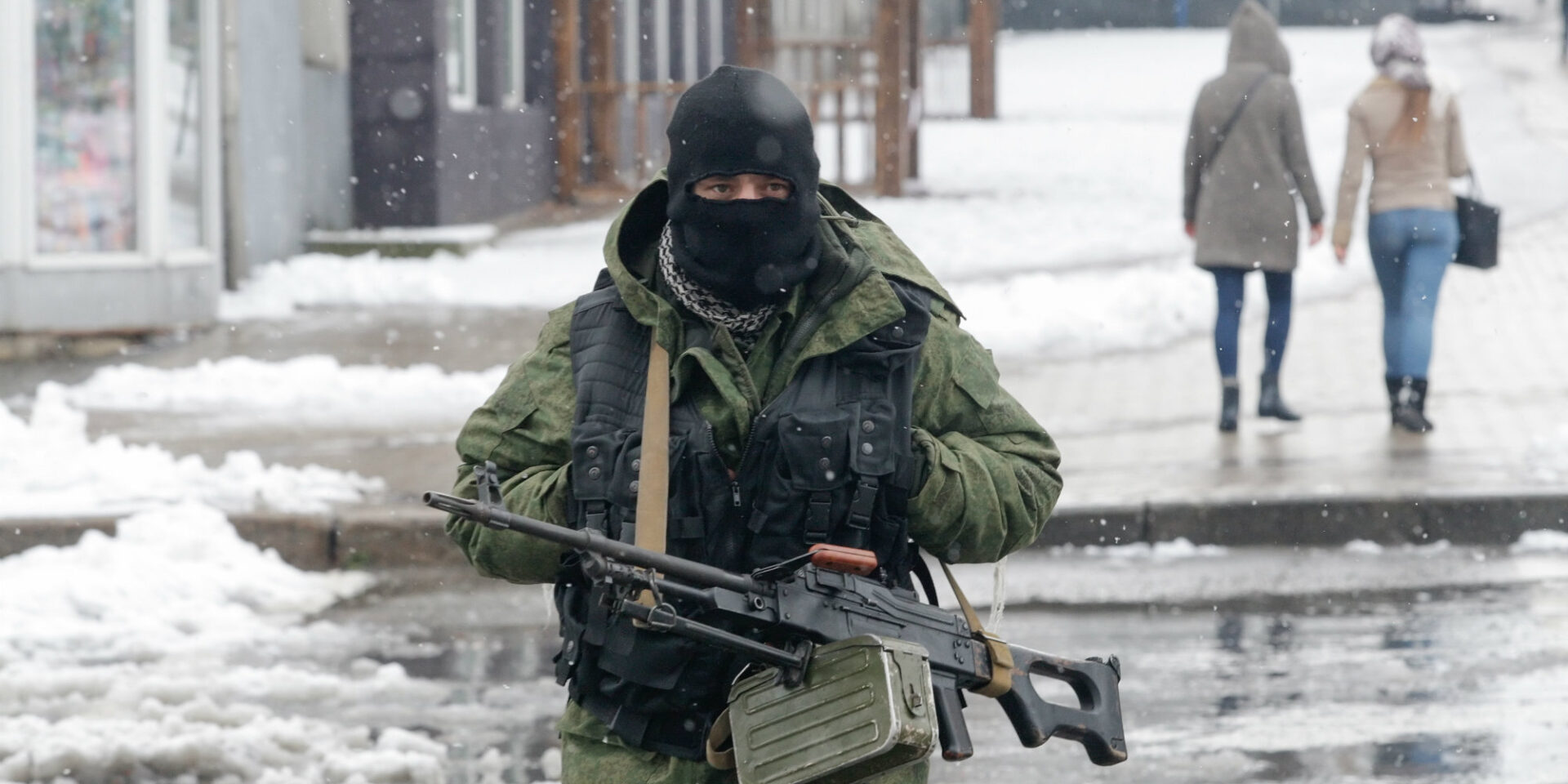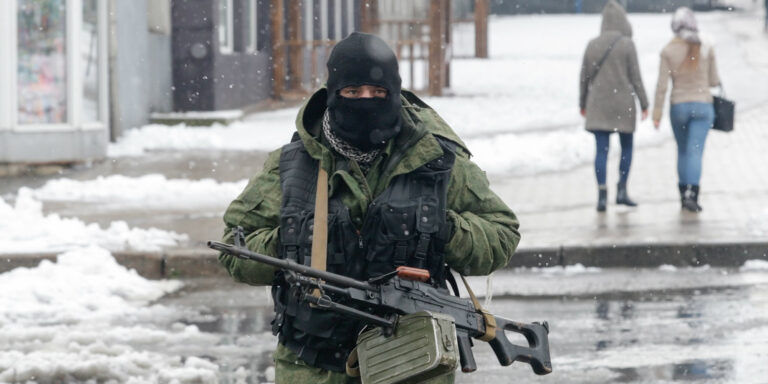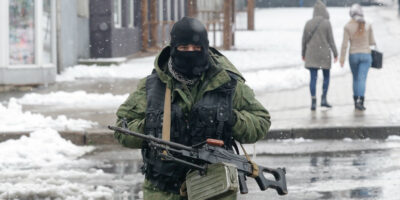“The gunpowder gets under your skin. The adrenalin is excellent, full of uncertainty, like sex in the wild,” says Stevan Milosevic, a Serb fighting for pro-Russian forces in the disputed region of Donbass in eastern Ukraine.
Milosevic, who is in his 30s, told BIRN in an interview conducted via Facebook that his working day as a sniper starts at around 6am with coffee and breakfast. After that, he is taken to his sniper position, which he sometimes has to hold for days.
His targets are Ukrainian soldiers in eastern Ukraine’s Donbass region. More than 10,000 people – civilians and fighters – have so far been killed in the conflict between Ukraine and separatist, pro-Russia fighters who refuse to recognise the Ukrainian government and in 2014 seized territory in eastern Ukraine.
Milosevic defends his actions by claiming Ukraine has not respected the Minsk agreements, signed by Kiev and Moscow in 2014 and 2015, which were supposed to ensure a ceasefire in eastern Ukraine. Fighting has continued with both sides rejecting blame for the failure of the ceasefire.
“They [Ukrainian fighters] are constantly using heavy weapons and shelling our positions, as well as villages inhabited by citizens and civilians,” he claims.
Milosevic is one of 29 Serbs convicted by Serbian courts since 2015 for fighting with pro-Russian units in Ukraine. Another 16 Serbs accused of fighting in Ukraine are currently awaiting trial. All those convicted agreed to plea deals that have, for most, resulted in suspended sentences of around one year. Three offenders were sentenced to six months under house arrest.
 |
| Photo: courtesy of Stevan Milosevic |
The prison terms have been suspended on condition those convicted do not commit the same offence within a set time period – usually between one and five years.
This hasn’t deterred Milosevic, who received a five-year suspended sentence in 2015, from returning to the battlefields of eastern Ukraine. He says he returned to Ukraine in August 2018 and is currently fighting for the Prizrak Unit, which is part of the International Brigade. Prizrak is the Russian word for ‘ghost’.
Partially redacted verdicts
In 2014, Serbia passed a law prohibiting citizens from fighting on foreign battlefields with military and paramilitary formations, unless part of an official mission of an international organisation of which Serbia is a member. Penalties range from six months to five years in jail.
Documents from Belgrade’s Higher Court obtained by BIRN after it submitted a freedom of information request show Serb fighters joined eight pro-Russian units. The papers also reveal hitherto unknown details of Serb fighters’ movements and actions, including combat, operations to secure military facilities and counter-intelligence tasks.
The documents list the following units Serbs fought with: the International Brigade, the Seventh Brigade, the Serbian-Hussar Regiment, the Ural Unit, the Batman Unit, the First Slavic Unit, the Rezanj Unit and also the notorious Wagner group.
While the court documents detail which units Serbian fighters joined and describe how Serbs participated in the conflict, a number of the names of those convicted and some details about how they were organised have been blacked out from all court papers, including the verdicts. This information would normally be made public.
It is also unclear how the fighters were arrested and whether they surrendered to the Serbian authorities.
The Higher Court said it had withheld names because of “personal data protection laws”.
The International Brigade
Most Serb fighters joined the International Brigade, also known as ‘Pyatnashka’, which, according to its official Vkontakte social media account, is fighting in the Donetsk region in eastern Ukraine.
According to the court documents, nine convicted Serbs, including Milosevic, who were fighting for pro-Russian separatists in Ukraine were part of this unit.
The papers also mention Nikola Perovic as one of the people who trained Serbian fighters for the International Brigade. The court papers do not specify whether he is among the convicted.
In a 2014 report published by the French newspaper Le Monde, Perovic is described as French-Serbian and is quoted as saying: “We will very soon leave for eastern Ukraine to fight alongside our Russian brothers”.
The International Brigade claims to have been first formed by 15 “volunteers from Russia” but soon more people joined.
“The brigade participated in almost all the breakthroughs of the army of New Russia on all fronts… it was engaged first in defence and then in driving out the enemy from the territory of the Donetsk airport,” reads the unit description on its Vkontakte account.
According to the court documents, Serbian members of the International Brigade were physically and tactically trained and also learned how to use weapons in eastern Ukraine.
Serbian fighters in this unit were given uniforms, automatic rifles and ammunition. They were in charge of guarding checkpoints and defending fighter positions. They also secured buildings and unloaded humanitarian aid.
BIRN sent questions about Serbian fighters to the International Brigade official email, but received no reply by the time of publishing.
Perovic has also been connected to the Unité Continentale by the Paris-based news portal World Crunch in an article published in 2014, in which Perovic was described as holding dual French and Serbian citizenship and having previously served as a master corporal in a French battalion that fought in Afghanistan.
On its official Facebook page, the Unité Continentale [Unit Continental] publishes news from the battlefield where, it says, it fights with the International Brigade. The unit also posts in the Serbian language and shares news on developments in Kosovo-Serbia relations.
Milosevic, who served with the Serbian Army between 2006 and 2012, told BIRN he first came to Donbass between October 2014 and January 2015 to fight with the International Brigade to “join the brothers in Donbass and help”.
He says his flight – via Moscow – was paid for by Unité Continentale, which he says helps Serbs to travel to Ukraine in order to fight. Unwilling to give full details of his route to Donbass, he describes the journey as difficult and that for one stretch: “You have to run, really fast, with everything you have on you, for about a kilometre and a half.”
Milosevic claims the Unité Continentale receives financial support from beyond Serbia to support its foreign fighters but says he later moved to the Prizrak Unit following a dispute over money with Unité Continentale.
BIRN emailed questions to the official email address of the Unité Continentale but did not receive a response by the time of publishing.
The Seventh Brigade
The documents show three convicted Serbs fought as members of this unit. According to the verdicts, Serbs in this unit were given automatic rifles and were tasked with securing buildings in Donetsk in 2015.
Some of them drove Soviet era T-64 tanks and combat vehicles. According to the Ukrainian authorities, this unit fought mostly in Donetsk city. The documents name one Nikola Jovic as fighting for this brigade. BIRN was unable to independently verify his identity.
According to the court documents, Jovic joined the brigade in March 2015 and received weapons and ammunition to fight in eastern Ukraine. However, he only stayed until April when he returned to Serbia. Six months later, he pleaded guilty and was handed a one-year suspended jail term.
The Serbian-Hussar Regiment
This unit was previously called the Oplot Unit but later changed its name. Serbs in this unit were tasked with securing facilities and were under the command of the recently killed Alexander Zakharchenko.
Zakharchenko’s death on August 31 was mourned among pro-Russian Serbian nationalists.
According to the court papers, seven Serbian citizens fought in the Serbian-Hussar Regiment including one named as Stefan Knezevic, said to be in charge of securing military facilities and receiving weapons and ammunition. He spent five months in Ukraine. BIRN has not been able to confirm this fighter’s identity.
Dimitrije Jojic, a Serb who was killed in Syria in June 2017, was also listed as having fought for this unit. According to the Serbian daily news outlet Blic, Jojic was killed while fighting on the pro-Russian side against jihadists.
He was buried in Moscow on June 28, 2017. On the same day, members of Serbia’s Vojvodina football fan club Firma (‘the Company’), held a special ceremony in the northern city of Novi Sad, where Jojic lived before going to Ukraine.
Jojic’s case shows how convictions have failed to prevent fighters returning to foreign battlefields given he was convicted in 2015 for fighting in eastern Ukraine with this unit. He is also said to have joined the Seventh Brigade.
Serbs in the Serbian-Hussar Regiment were securing military checkpoints at the border in the Debaltseve region in the Donetsk area.
The creation of the unit was officially announced on November 21, 2014, with a video inviting Serbs to join.
According to the court documents, Serbs who went to fight as part of the Seventh Brigade entered Ukraine near the city of Alchevsk in Luhansk Region.
The Serbian-Hussar Regiment was eventually disbanded and all Serbs who joined it eventually moved to the Seventh Brigade. The court documents show that one of the fighters from the Serbian-Hussars, after joining the Seventh Brigade, then decided to join the First Slavic Unit.
Wagner mercenaries
A Russian group, the Wagner Private Military Company, employs mercenaries who are believed to have played an important role in battles fought by pro-Russian separatists in eastern Ukraine and, from 2016, also in Syria.
Russian officials have long admitted the presence of volunteer fighters in the Donbass region of eastern Ukraine and in Syria, where Moscow supports the Damascus government but denies any links to Wagner.
In February, Ukraine security service official Igor Guskov told Ukrainian television that at least seven Serbian mercenaries were fighting in eastern Ukraine as part of Wagner, one of whom was killed.
“We are well aware of seven Wagner mercenaries. One of them was killed,” Guskov told journalists without specifying the name of the killed Serb or the date of his death.
Milosevic refers to Wagner fighters as “mercenaries” and says the group “helps people here [in eastern Ukraine] travel to Syria” to fight.
According to the court papers, Slobodan Stanisic was one of the convicted Serbs who fought as part of this unit. He is said to have joined Wagner in 2015 and returned to Serbia in September the same year.
After he was given an automatic rifle and ammunition, Stanisic was tasked with securing the Agronomic Faculty buildings in one of the cities in Donetsk, where the whole unit was based. He pleaded guilty and received a one-year suspended sentence.
BIRN tried to contact Stanisic via his Facebook account but received no reply by the time of publishing.
The Ural Unit
The Ural Unit was not so popular among Serbs. According to the documents, two people were convicted for being part of this unit including one named as Igor Knezevic – who fought in Ural’s Thunder platoon in 2015 in eastern Ukraine. BIRN has not been able to independently verify Knezevic’s identity.
Documents also revealed that a second fighter, whose name remains unknown, was also part of the Thunder group and was responsible for intelligence work and also for arresting people accused of gathering information for the Ukrainian secret service.
The First Slavic Unit
Four Serbian citizens have so far been convicted of fighting in this unit. According to the court documents, Serbian fighters were based in Novoazovsk, a border town on the south-eastern tip of Ukraine in the Donetsk region. They were tasked with securing military facilities.
One of the verdicts reveals that one Serbian fighter was also in charge of securing a jail in Komisarovka in the Mykolayivs’ka region in southern Ukraine. Another fighter operated road checkpoints in Donetsk.
The Batman Unit
One Serbian citizen was convicted of fighting with the Batman Unit. According to the court verdicts, he received large numbers of weapons including hand-held rocket launchers and fought in the area near to the Donetsk airport, Debaltsev, and Donetsk city Dokuchaievsk and at the Mariupol region.
According to the documents, this fighter stayed in Ukraine until October 2015, ten months after the Batman Unit commander, Alexander Bednov, was killed during an attack on his convoy.
The Batman Unit was disbanded after the incident.
The Rezanj Unit
According to the documents, one Serbian citizen was the driver for the deputy commander of this unit in Donetsk and was also part of the Security Service Battalion. This fighter carried out “counter-intelligence protection” jobs and later also became commander of the Batman Unit.
The unit came to the Serbian public’s attention for the first time in October 2014 after Serbian citizen Dejan Beric sent a letter claiming he fought for this unit that was published on the right-wing website Koreni.
He said the Rezanj Unit was formed at the very beginning of the fighting in eastern Ukraine as a scout diversion group with people from all former republics of the USSR.
 |
| Infographic: BIRN |
Belgrade-Kiev tensions
Relations between Serbia and Ukraine have been badly damaged by the presence of Serb fighters among pro-Russian separatist groups in Ukraine.
Ukraine’s ambassador to Serbia, Oleksandr Aleksandrovych, told BIRN in November 2017 an estimated 300 Serbs were fighting at that time in Ukraine. The ambassador accused the Serbian authorities of ignoring the issue, which it believes has been complicated by Serbia’s close ties with Russia.
Last month, Serbia’s Justice Ministry told BIRN that the Ukrainian authorities had never contacted them about Serbs fighting in Ukraine. However, the same month Serbia’s Foreign Ministry confirmed to BIRN it had received three diplomatic letters so far – one dated January 11, 2018, another November 27, 2017, and one July 24, 2015.
BIRN has now obtained copies of all three letters. In the 2018 and 2017 letters, Ambassador Aleksandrovych requested meetings with the Serbian prosecution and court officials regarding the “cooperation on delivery of information about Serbian citizens fighting in the east of Ukraine”. The Foreign Ministry replied to both with concrete dates for meetings.
However, according to the 2015 letter, the Ukrainian embassy also sent the Serbian Foreign Ministry a list of Serbian citizens who they said had participated in armed conflict in Donbass.
“The Ukrainian embassy is asking that this information is sent to the address of all competent institutions of Serbia. The embassy is also asking to be informed if listed citizens are being held [arrested] in Serbia or are facing criminal charges.”
The Foreign Ministry did not give BIRN the list of names given to it by the Ukrainian ambassador, saying it has the right to protect data if there was a threat to national security or relations between Serbia and other states.
The office of the Ukrainian Prosecutor General told BIRN in October this year it had identified six Serbs fighting in Ukraine as part of one of its own separate pre-trial investigations into “foreign fighters taking part in waging the aggressive war against Ukraine”.
The prosecutors’ office said it had sent a request to “the competent authorities of the Republic of Serbia about providing international legal assistance for conducting legal proceedings” against those accused of fighting illegally in Ukraine but had not received a response.
‘Serbia must turn to Mother Russia’
In 2014, Aleksandar Vucic, then Prime Minister now Serbian President, called on all Serbs fighting in Ukraine to return to Serbia.
“The engagement of our citizens for money in these conflicts is damaging the state,” he was quoted as saying by the Serbian news agency Tanjug.
Despite Vucic’s call, many Serbs say they felt compelled to join separatist units out of sympathies with Russia and a sense of Orthodox Christian brotherhood.
Milosevic himself proudly claims to have set up an organisation in his hometown of Kovin, in northern Serbia, called The Centre for the Preservation of the Tradition of Serbian-Russian Orthodox Fraternity.
This year the group organised Kovin’s week-long Russian film festival and Immortal Regiment parade to mark the Soviet Union’s defeat of Nazi Germany in World War II.
 |
| Photo: courtesy of Stevan Milosevic |
There are also reports that foreigners fighting in eastern Ukraine are well paid.
Sniper Milosevic says the Luhansk People’s Republic – a self-proclaimed state in eastern Ukraine that declared independence in 2014 – pays him a monthly salary of 15,000 roubles (200 euros).
He denies any suggestion he is a paid mercenary, describing himself instead as a salaried soldier fighting for a legitimate armed force. He stresses the salary is not large enough for him to endanger to his life solely for financial gain.
“The risk is huge. We snipers and miners do the toughest things and there is no room for any mistakes,” he says.
Others note that the relatively lenient sentences for those Serbs who have been convicted of fighting in Ukraine has hardly served as an effective deterrent to returning to the Ukrainian battlefields.
Milosevic, for one, is resolutely unfazed by the potential consequences of breaking the terms of his suspended sentence if he returns to Serbia. He dismisses the law under which he was sentenced as not having “any future”, predicting it will be scrapped.
He also hasn’t taken Vucic’s call to cease fighting in Ukraine particularly seriously.
“Dogs bark but the caravan passes,” he says. “If Vucic wants to survive [politically], he has to urgently turn to the East and Mother Russia, anything else is ruinous for the Serbian people and the country.”
The story originally written and published BIRN Belgrade







